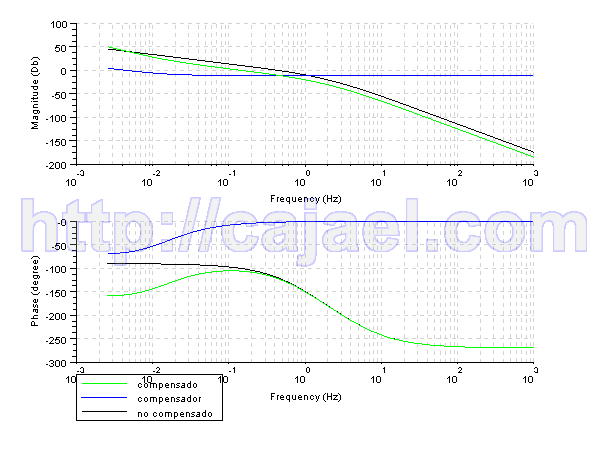[adsense:responsibe:9545213979]
Cuestion 2 (regulador PI, error de posicion)
Solapas principales

SOLUCION:
Primero vamos a calcular el polo dominante que queremos:
![]()
![]()
![]()
Ahora vamos a obtener el angulo de fase que tenemos para este polo del sistema
![]()
Como se ve necesitamos hacer un atraso de 60 grados para situarnos en -180. El regulador que utilizaremos sera un PI
![]()
![]()
![]()
![]()
Con lo que el regulador nos quedara:
![]()
Ahora calcularemos la 
![]()
![]()
![]()
El sistema sera:
![]()
El error de posicion es cero por ser de tipo 1 el sistema compensado.
Vamos a hacer los calculos y las comprobaciones de resultados con el Scilab
s=%s;
zet=0.5;
wn=1;
sig=zet*wn
wd=wn*sqrt(1-zet^2)
s1=-sig+%i*wd
g=2/((s+1)^2);
gs=syslin('c',g);
aux=horner(gs,s1);
aux2=atan(imag(aux),real(aux));
anggs1=360*aux2/(2*%pi)
anggc=-180-anggs1
aux3=atan(imag(s1),real(s1));
angs1=360*aux3/(2*%pi)
aux4=anggc+angs1
aux5=(2*%pi)*aux4/360;
a=sig+(wd/tan(aux5))
aux6=(s+a)/s;
aux7=aux6*gs;
aux8=abs(horner(aux7,s1))
kc=1/aux8
gc=kc*aux6;
gt=g*gc;
gts=syslin('c',gt)
clf;
evans(gts)
plot(real(s1),imag(s1),'*')
plot(real(s1),-imag(s1),'*')
mtlb_axis([-2 1 -1.5 1.5])

Español



Añadir nuevo comentario